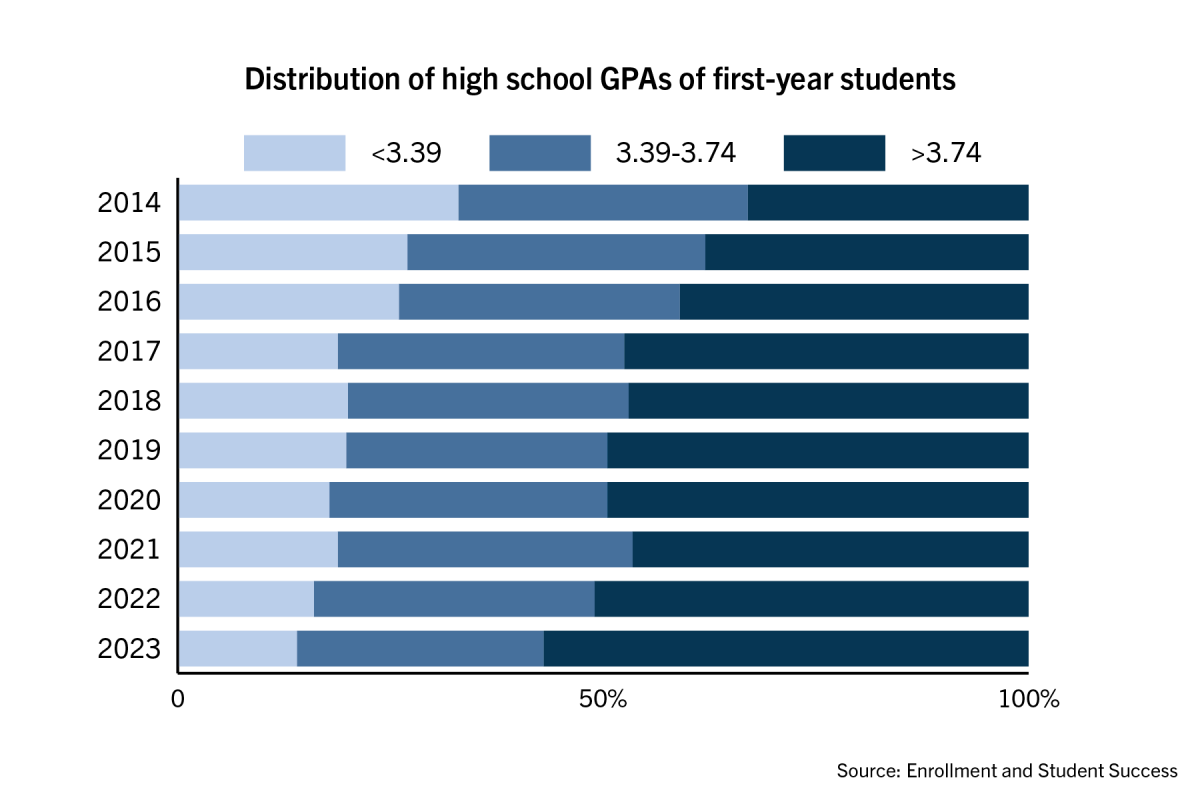The share of incoming students with top high school GPAs surged in 2023, according to a report presented at a Faculty Senate meeting earlier this month.
The percentage of students who have enrolled at the University with a high school GPA of 3.9 or above reached a decade-high last year, increasing from 18 percent in 2014 to 34 percent in 2023, according to the report. Provost Chris Bracey and experts in higher education administration said grade inflation during the COVID-19 pandemic could have caused the rise in average high school GPA among first-year students.
“This is an indication that we’re continuing to improve academically in terms of the quality of students that we matriculate year over year,” Bracey said at the meeting. “That said, I will be fair here, this may also be an indication of grade inflation.”
The number of incoming students with a GPA of 3.39 or lower dipped from 33 percent in 2014 to 14 percent in 2023, according to the report.

Bracey said incoming students’ rising average high school GPAs serve as a “good indicator” of high-performing students’ interest in attending GW. He said officials track the high school GPAs for admitted students as a measure of academic performance because the University’s test-optional admissions policy made it impossible to compare all applicants using SAT and ACT scores.
GW has been a test-optional university since 2015.
A 2022 ACT study reported a rise in high school GPAs and a drop in standardized test scores that suggested grade inflation was present. The average American high school GPA rose from 3.17 in 2010 to 3.36 in 2021, while the average ACT score, graded on a scale from 1 to 36, dropped from 21.4 to 20.17, according to the study.
Bracey said grade inflation may contribute to the rise in average high school GPAs among first-year students, but the growth in retention rate for first-year students suggests they are prepared for college-level work. The University retained 91.9 percent of the class of 2026’s first-year students, a 3.9 percent increase from 88 percent of students who enrolled in 2019.
“If it were due to just grade inflation, you would expect that retention rate to be lower,” Bracey said at the meeting.
Experts in higher education administration said flexible grading policies and a shift to a pass/fail system in some high schools during the pandemic may have inflated applicants’ GPAs because the metric may not factor in all their coursework.
Dan Goldhaber, the director of the Center for Education Data & Research at the University of Washington and the CALDER Research Center, said the center’s researchers collected evidence showing an uptick in grades during COVID-19. He said the average GPA for high school students has grown slightly over the last decade because of factors like “grade compression,” meaning little variation in the grades students receive despite disparities in quality of work.
“There is evidence, not just our evidence, but evidence from other sources that suggests grades have been creeping up over at least the last decade,” Goldhaber said. “And then, as we show, there was a real spike in grades connected with the pandemic.”
Goldhaber said to combat grade inflation, test-optional universities should examine grade distributions among the states and school systems students come from. He said it could be difficult for universities to adopt the method because the information is not usually readily available.
Jeremy Lowe, the assistant vice provost for undergraduate admissions at American University, said in the last decade he has not seen a “statistically significant” increase in high school GPAs among applicants.
“This is my 13th year here at AU and the academic profile based on our GPA has remained in a really consistent place,” Lowe said. “We haven’t seen huge shifts up or down within both our applicant pool GPA and the GPA of students that we’re admitting.”
Lowe said universities can detect inflated GPAs among applicants by seeing if high schools offered a pass/fail option during the pandemic. He said academic performance in those courses was omitted from the overall calculation.
“When you are limiting the number of years that you’re using an ABCDF scale or a traditional 4.0 scale, you could see an increase in a GPA because of something like that,” Lowe said.
Lowe added that American evaluates the rigor of each high school in the country and considers applicants within the context of the school they attended.
“Our expectation is that a student is challenging themselves within what their high school is providing to them,” Lowe said.
Barbra Rosenstein, an independent educational consultant based in California and a GW alum, said during the pandemic some high schools offered grading policies like pass/fail. She said these relaxed policies allowed some students to earn grades that were not reflective of their true academic performance.
“When March 13 happened and schools had to go virtually online, they were given whatever your grade is now, you can take that, you could go to pass/no pass, or you could try to earn a higher grade,” Rosenstein said.
Amanda Kelly, a high school senior who committed to GW’s Class of 2028, said she thinks her GPA would have been lower if she didn’t have a pass/fail option for online classes during the pandemic.
“Those were my best grades by far,” Kelly said. “Classes were insanely easy to me and I feel like I definitely know that for sure because my sophomore year seemed so much harder.”





